Château Marquis de Terme is a legendary Bordeaux winery and one of the Fourth Growths on the famous 1855 Classification of Bordeaux wines. Family-owned by the Seneclauze family since 1935, the history dates back much further with twists and turns including creation out of a marriage dowry.
Sitting on the doorstep of Margaux, Château Marquis de Terme is emblematic of both how many Bordeaux châteaux were once created and of the famous Margaux terroir. Though a Grand Cru Classé and world-renowned wine, the family has catapulted the château into modern times. With fun visits like their bike rides to discover their organic vineyards and the 1855 Grand Cru Classé tasting for wine connoisseurs that introduces you to each of the seven appellations included in the famous classification of Bordeaux wines, Château Marquis de Terme shouldn’t be missed during your visit to Bordeaux.
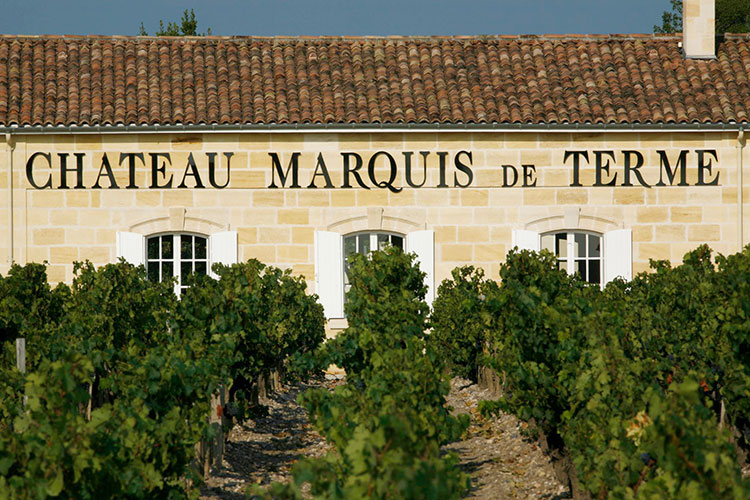
The History of Château Marquis de Terme
Château Marquis de Terme, like so many Bordeaux wine estates, has a long history of changing hands through wealthy Bordelais families. Originally owned by Bernard de Faverolles, he sold the estate in 1661. It was sold on September 7 to Pierre des Mesures de Rauzan, and at that time the sale created one of the largest wine estates in the Bordeaux wine region.
The estate owned by Pierre des Mesures de Rauzan was split up into four different estates, all that would become classified growths in the 1855 Classification: Château Rauzan-Segla, Château Rauzan Gassies, Château Desmirail and Château Marquis de Terme.
The château’s history under the name Château Marquis de Terme officially began in 1762. It was created as a marriage dowry when Ledoulx d’Emplet offered the château to François de Peguilhan, Marquis de Terme who was marrying her daughter, Elizabeth de Ledoulx d’Emplet.
Though the château would be classified as a Fourth Growth in the Médoc Classification of 1855, the estate was already made famous in the 1700s. American President Thomas Jefferson, who was a wine connoisseur, visited Bordeaux in 1787. He declared Château Marquis de Terme as one of the 16 best Bordeaux wines he tasted.
Today the château is still owned by the Seneclauze family, who purchased it in 1935.
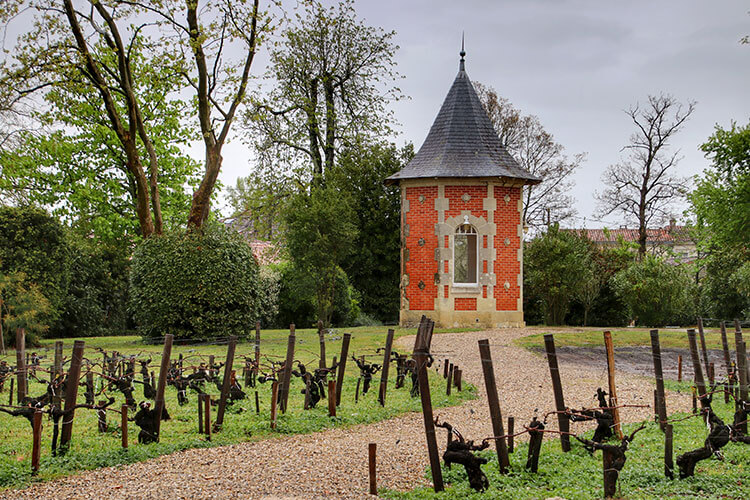
The Visit at Château Marquis de Terme
There are several options for visits at Château Marquis de Terme. All the various visits start in the vineyard, which spans both the villages of Margaux and Cantenac.
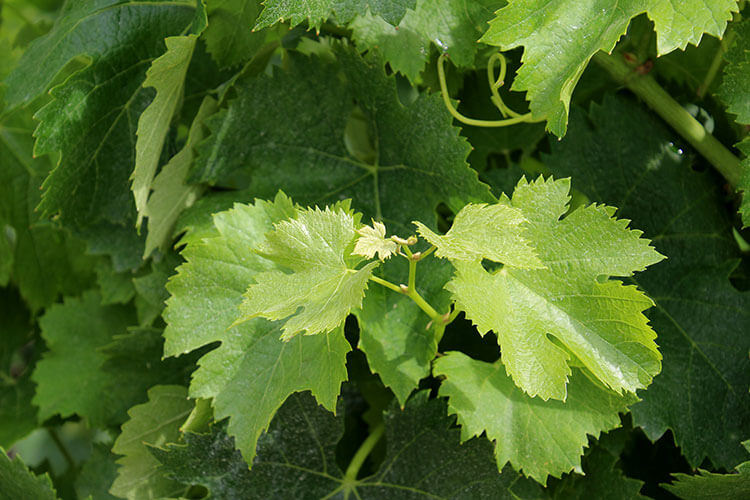
Located on the Margaux plateau, Château Marquis de Terme is one of the best examples of the Margaux terroir. With 39 hectares of vines in total, 5.5 hectares are grown in the shallow, fine gravel with a low proportion of clay that is unique to the Margaux plateau. As with all Left Bank Bordeaux wines, Cabernet Sauvignon is the dominant grape and 60% of the château’s vines are Cabernet Sauvignon. The remainder are made up of 35% Merlot and 5% Petit Verdot, which is the grape we love that gives some peppery-ness and spice to the wine.
Even though Château Marquis de Terme is on the larger side of wineries when it comes to Bordeaux, the vineyard is managed on a plot-by-plot basis. The grapes are hand picked and only the very best grapes go on to become wine.
Careful consideration is also given to the environment, and as of 2017, Château Marquis de Terme was certified as an organic winery. Their vineyard management uses 100% organic techniques.
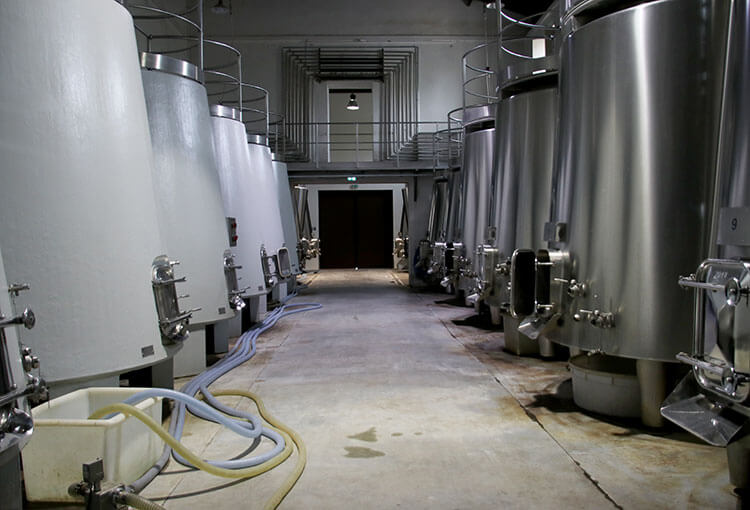
All visitors get a look at the winery where the wine making takes place in Château Marquis de Terme’s cement vats, which range in size from 80 hectoliters up to 250 hectoliters. But those taking part in the 1855 Grand Cru Classé Tasting get an extra special look from the walkways above. It’s the winemaker’s view of the vat room.
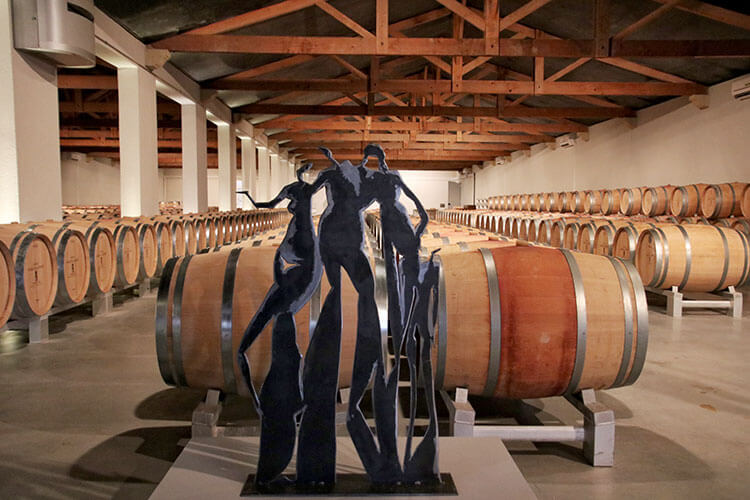
In the barrel room, wine and art collide with exhibitions curated among the barrels. It’s here that the wine ages for 18 months in 50% new French oak barrels.
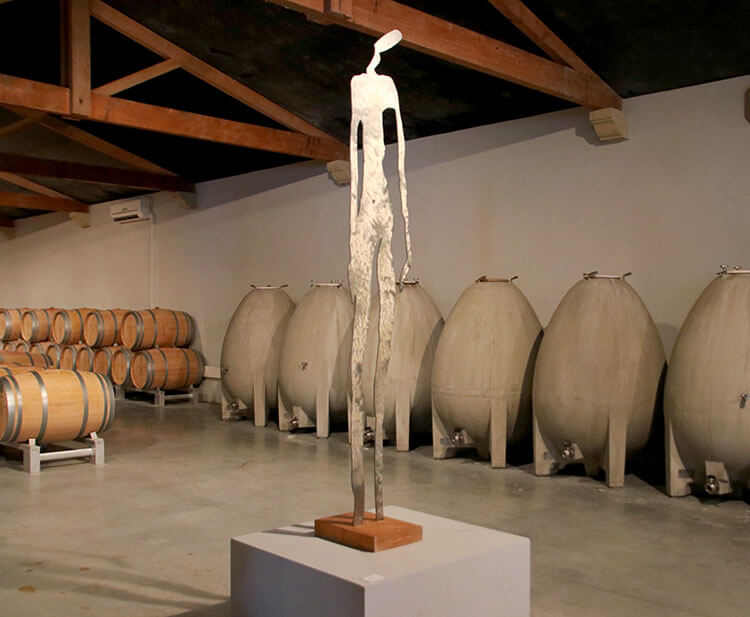
Château Marquis de Terme also uses some Nomblot concrete eggs for aging about 8% of their production. These special eggs cause micro-oxygenation during the aging thanks to the lees (yeast) continually being forced upward in a sort of vortex from the shape.
You’ll also see one other experiment that became a successful part of the wine making process at Château Marquis de Terme: the row of upright egg-shaped barrels lining the left wall of the barrel room. These are special as the wine making and aging all takes place inside from grape to finished wine.
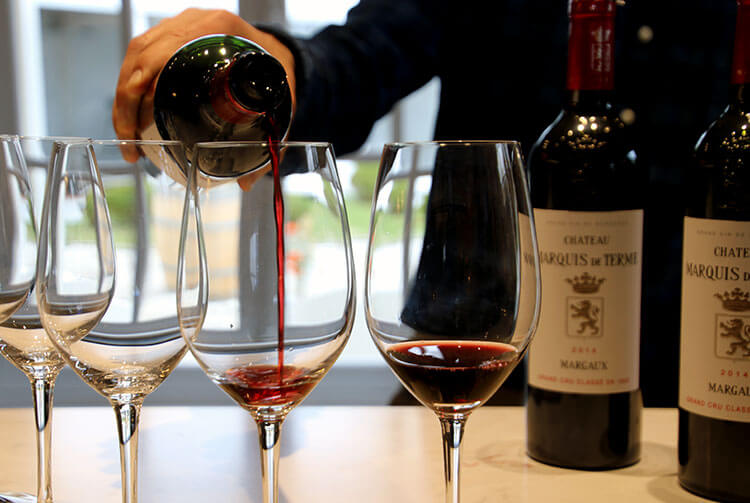
The classic visit ends with a tasting of the first and second wines of the château back in the shop/tasting room.
1855 Grand Cru Classé Workshop
The 1855 Classification of Bordeaux wines is, to this day, the most important and famous classification of any wine region in the world. In the just over 160 years since this classification, only one modification to it was ever permitted.
The 1855 Classification is the first official classification of wines from Bordeaux, but there were a few other unofficial classifications prior. The first unofficial classification came about sometime in the 1600s when Bordeaux wines were first sought out by buyers for specific appellations thanks to the notoriety of wineries like Château Margaux, Château Lafite, Château Latour and Château Haut-Brion.
Thomas Jefferson, before he became the third President of the United States, spent time in France while serving as the first American foreign minister to France. He came to Bordeaux in 1787 and created his own Médoc classification, which included three levels of classification.
It was from Jefferson’s classification that the idea of the Growths was born, and these First – Fifth Growths would eventually take hold during the 1855 Classification.
Jefferson was a supreme wine connoisseur. Many of his picks for the best wines in Bordeaux would be included in the 1855 Classification, with Château Margaux, Château Lafite (today Château Lafite Rothschild), Château La Tour Segur (today Château Latour) and Château Haut-Brion being classified as First Growths under both Jefferson’s classification and the 1855 Classification.
It was Napoleon III who asked for the classification of French wine regions. For the Exposition Universelle de Paris in 1855, which was similar to the World’s Fairs of today, Napoleon saw it as an opportunity to showcase the best France had to offer.
At the time there were, like still today, thousands of Bordeaux châteaux producing wine. Some sort of organization would need to be established to discern the best of the best.
So in April of 1855 Napoleon III asked the Bordeaux Chamber of Commerce to create the classification. The Bordelais knew what a hornet’s nest that would be, and washed their hands of it by appointing the Syndicat of Courtiers (Wine Broker’s Union of Bordeaux) to create the list.
It took them approximately two weeks, but they soon turned out a list that included 58 châteaux all from the Left Bank and included: 4 First Growths, 12 Second Growths, 14 Third Growths, 11 Fourth Growths and 17 Fifth Growths. The classification only included the appellations of Haut-Médoc, Margaux, Saint Julien, Pauillac and Saint Estephe, along with the sweet wine appellations of Sauternes and Barsac.
It was, as expected, wrought with controversy. While the negociants insisted that their list had no hierarchy, the original was in fact written to rank each château on it by quality. Château Mouton Rothschild originally appeared at the top of the list of Second Growths. The list was re-written to list the château in each growth by alphabetical order.
Only one change was ever permitted to the official 1855 Classification and that was in 1973 when Baron Philippe de Rothschild succeeded in having Château Mouton Rothschild elevated to a First Growth.
The only other change to the official 1855 Classification list is the number of châteaux on it. Originally it listed 58 châteaux, though today the number is 61 due to the sale and division of some of the original wine estates on the list.
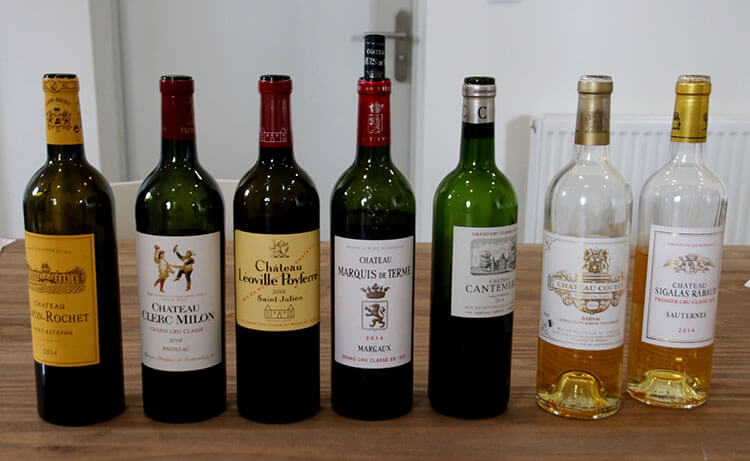
The 1855 Grand Cru Classé workshop is unique because Château Marquis de Terme is the only château where you can taste wines of other châteaux. Not only do you learn about the history of the 1855 Classification, but you taste a wine from each of the seven appellations included in the classification.
The same year is chosen to give you the same characteristics of weather effects on the terroir across the seven appellations, and our tasting was from the 2014 vintage. You taste from the south to the north as the wines get stronger heading from south to north, and finish with the Sauternes then Barsac appellations.
The tasting is a bit heavy with so many rich wines, so it is broken up differently than the classic visit when you taste at the end. Instead, after visiting in the vineyard you taste the first three wines.
We began with Château Cantemerle, a Fifth Growth from the Haut-Médoc. It’s lighter, but balanced and easy to drink. Next came the Château Marquis de Terme from the Margaux appellation, which is well-balanced with medium tannins. You can taste both the blackberries, but also the vanilla and tobacco with the pepper finish from the Petit Verdot in the blend. The final wine, for now, is Château Léoville Poyferré. It’s a Second Growth from the Saint Julien appellation and is deep and complex.
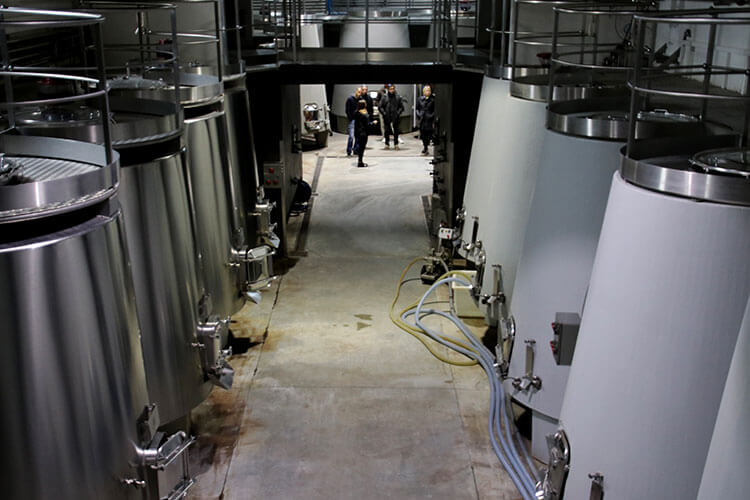
Time for a little break from tasting, you visit the vat room for the special look from the walkways above usually only accessed by the winemaker and staff. The tasting then continues with Château Cleric Milon, a Fifth Growth from the Pauillac appellation. It’s extremely floral and packed with ripe fruits, but still has a spiced finish. The final red wine is Château Lafon-Rochet, a Fourth Growth from Saint Estephe. It’s elegant with black currant and a clear oak, but the oak isn’t overpowering.
Readying the palette to switch the sweet wines of Sauternes and Barsac, you now take a little break to visit the barrel room. After, the tasting continues with first Sauternes from Château Sigalas Raubaud, a Premier Grand Cru Classé located in Bommes. It’s still young, but delicious with the taste of pineapple. Château Coutet Barsac follows, and though the year is the same this one has developed a bit more of the caramels already that come with aging in Sauternes and Barsac.
Until you taste Bordeaux wines in a tasting like this, you really don’t realize how different they are from château to château and appellation to appellation. It’s in a tasting like this that you can really start to appreciate how the terroir lends such different properties to the same grape varietals.
Know Before You Go
This article contains affiliate links. When you book on Rue des Vignerons through our affiliate partner sites, we earn a small commission at no additional cost to you.
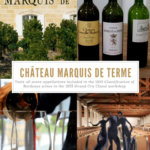
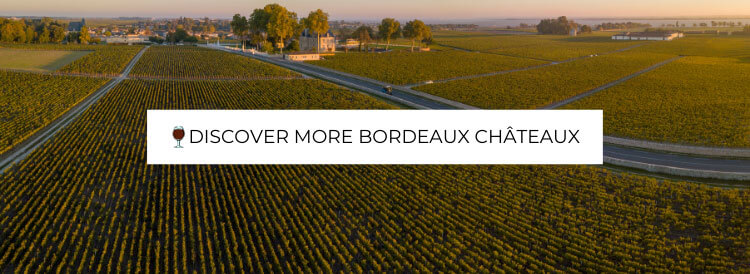
Leave a Reply